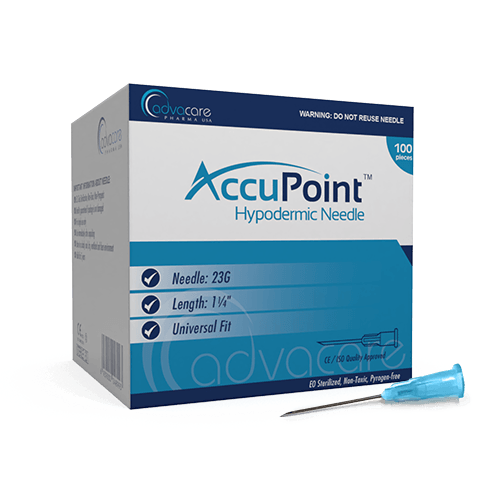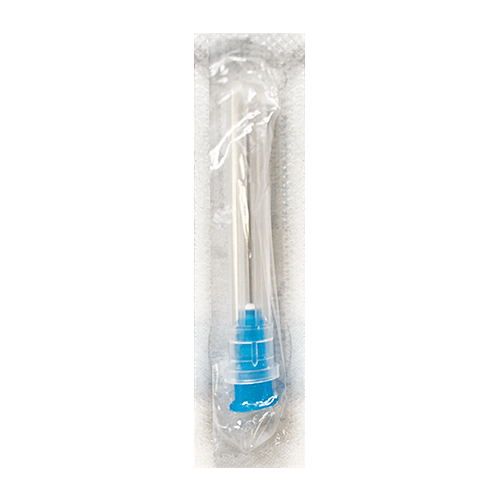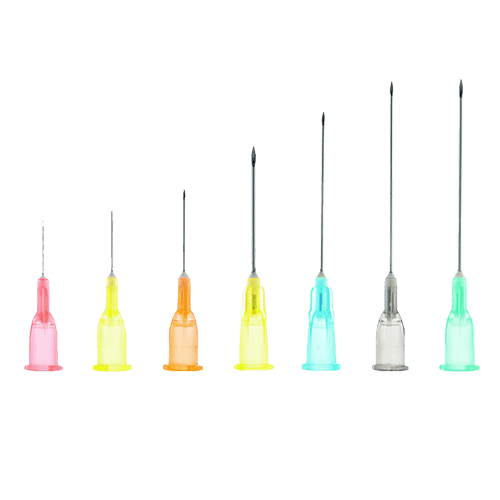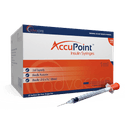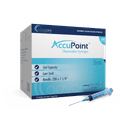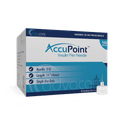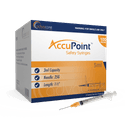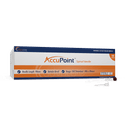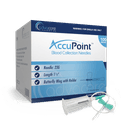- Home›
- Medical Devices›
- Injection Instruments›
- Injection & Precision Instruments›
- Hypodermic Needles
Hypodermic Needles
Needle Gauge (color-coded)
Needle Length
Packaging
What are Hypodermic Needles?
Hypodermic Needles are small and sharp needles that are used to inject fluids into the body or extract fluids for testing purposes. They come in different sizes, ranging from 16G to 28G, with larger numbers indicating thinner needles. These injection needles are designed to be single-use disposable items.
Hypodermic needles have various applications in the medical field, such as administering medications or vaccines, drawing blood samples for diagnostic tests, or draining fluids from abscesses or cysts. The needle's length and gauge depend on the injection site and the fluid being injected, with larger needles typically used for thicker fluids and larger doses.
AdvaCare Pharma's Hypodermic Needles are manufactured in facilities in China, India, and the USA, using the highest quality materials and strict quality control procedures. Our products are designed to meet the needs of healthcare providers and patients worldwide, and are backed by our commitment to excellence in every aspect of the production process.
Product Specifications
Features
Hypodermic Needles are available in various gauges and lengths to accommodate different administration requirements. The Birmingham gauge is the primary system used to measure the diameter of the needle.
Standard sizes for general use are usually thinner needles ranging from 23G to 27G, while oil-based solutions, serums aspirating, and other applications may require wider gauges, ranging from 16G to 22G. The appropriate needle gauge and length depend on several factors such as the injection formulation, target tissue, and patient population.
One of the essential features of hypodermic needles is their ability to be sterilized and made non-toxic and non-pyrogenic for safe use. One method of sterilization is through gas sterilization, which ensures that the needles are free from harmful microorganisms that may cause infections. Additionally, hypodermic needles are designed to be single-use disposable items, which eliminates the risk of cross-contamination and infection transmission.
Why are we a trusted Hypodermic Needles manufacturer?
AdvaCare Pharma is a trusted manufacturer of Hypodermic Needles, providing reliable and safe medical devices to distributors, hospitals, pharmacies, NGOs, and government institutions in over 65 markets worldwide.
Our AccuPoint™ brand products are manufactured in ISO and CE-certified facilities, with rigorous quality control measures in place to ensure that our medical distributors receive only the best-quality products. Additionally, all AccuPoint™ medical devices are accompanied by a STED dossier, and we can provide CE, ISO and FDA certifications for some product specifications.
As a quality-focused hypodermic needle manufacturer, we pride ourselves on our data-driven and methodical approach to supply chain management. Our commitment to quality is reflected in our frequent internal and third-party facility inspections, which ensure that our medical devices meet and exceed the standards required by our partners.
Uses
How should Hypodermic Needles be used?
To administer injections or draw fluids safely, hypodermic needles require careful handling:
- Begin with a thorough inspection to confirm the needle's cleanliness and integrity. Handwashing is paramount for both practitioners and patients before any procedure.
- When preparing for an injection, cleanse the target area with an alcohol swab, allowing it to air dry completely.
- Selection of the needle gauge and length should be based on the medication's viscosity and the depth of the intended injection site.
- Insert the needle at the angle recommended for the specific type of injection, which typically is perpendicular to the skin, so the medication is delivered accurately and with reduced discomfort for the patient.
- After administering the medication, the practice of reusing needles is strongly discouraged due to the risks of infection and contamination.
- Should any complications or unexpected reactions occur, it is imperative to seek medical attention immediately.
How should Hypodermic Needles be disposed of?
Once used, needles should be directly placed into a puncture-resistant sharps container, specifically designed to safely contain and eliminate the risk of needle-stick injuries.
These containers are an integral component of medical waste disposal practices, making sure that sharp objects are securely contained until they can be properly processed.
What are the different needle gauges available for Hypodermic Needles, and how do they affect the needle's use?
Hypodermic needles come in a spectrum from 16G to 28G, where the gauge number inversely related to the needle's diameter. The thickness of the needle influences both the flow rate of the medication and the level of discomfort experienced during the injection.
Lower gauge numbers indicate thicker needles, which are typically utilized for delivering larger volumes of medication or for substances with higher viscosity. Conversely, higher gauge numbers signify thinner needles, preferred for less invasive procedures and where precision is demanded, minimizing tissue disruption and patient discomfort.
Can Hypodermic Needles be used for purposes other than medical applications?
While primarily manufactured for medical purposes, including administering medications or vaccines and drawing blood, hypodermic needles also find applications in various non-medical fields such as biotechnological research, experimental science, and even in artistic practices that require precision and sterility.
Approach their use outside medical contexts with caution, recognizing the inherent risks and keeping appropriate safety measures in place to prevent injury or infection.
What precautions should be taken when using Hypodermic Needles to prevent complications or adverse reactions?
Implementing stringent precautions is central to the safe use of hypodermic needles:
- Maintaining hygiene, checking the needle and injection site are sterile, and selecting an appropriate needle based on the procedure's requirements are foundational steps.
- Avoid the reuse of needles to prevent the transmission of infections.
- In the occurrence of complications or adverse reactions, the importance of immediate consultation with healthcare professionals cannot be overstated, as timely medical intervention can mitigate potential health risks.
Are Hypodermic Needles single-use items?
Designed for a single application, the disposable nature of hypodermic needles is a cornerstone of modern medical practice. This approach reduces the likelihood of cross-contamination and the spread of infectious diseases, leading to each patient being treated with a sterile, uncontaminated instrument.
This practice aligns with broader healthcare safety protocols, emphasizing the importance of minimizing infection risks in clinical settings.
How should Hypodermic Needles be stored to maintain their quality and safety?
Storing hypodermic needles in an environment that is clean, dry, and temperate preserves their sterility and functionality.
Until ready for use, needles should remain in their original packaging, shielded from any potential contaminants. Secure storage away from the reach of children and pets to prevent accidental injuries.
Can Hypodermic Needles be safely disposed of in regular household waste?
It is imperative that hypodermic needles are not discarded with regular household waste due to the injury and health risks they pose.
Specialized sharps disposal containers should be used to contain used needles, following local regulations and guidelines for medical waste. This ensures the safety of waste handlers and the general public, preventing unnecessary exposure to potentially hazardous medical waste.
FAQs
How do Hypodermic Needles work?
Hypodermic needles are inserted into the body to inject medications, fluids, or extract blood or other fluids for testing purposes.
What do the different needle gauges mean?
The gauge refers to the thickness of the needle; the larger the gauge number, the thinner the needle. For example, 16G needles are thicker than 28G needles.
What is the difference in needle length for Hypodermic Needles?
The length of the needle varies depending on the intended use. Shorter needles, such as 5/8 inch, are used for subcutaneous injections, while longer needles, such as 1 1/2 inch, are used for intramuscular injections.
How should Hypodermic Needles be stored and handled?
Hypodermic needles should be stored in a clean, dry, and cool place away from direct sunlight. They should be disposed of after a single use in a designated sharps container to prevent the spread of infection.
Are Hypodermic Needles only used for medical purposes?
While hypodermic needles are primarily used for medical purposes, they may also be used in other fields such as science, research, and art. However, it is important to note that the use of hypodermic needles carries a risk of injury and infection, and proper precautions should always be taken.
What is the scope of medical devices that your company offers?
We produce a diverse range of over 500 Class I and Class II medical devices, spanning surgical instruments, diagnostic tools, medical consumables, wound care items, and urological equipment to meet the clinical needs of healthcare providers across the hospital, clinic and pharmacy sectors.
What quality assurance measures are in place for your Hypodermic Needles?
We enforce rigorous quality assurance procedures across all stages of production and distribution for our medical devices, bolstered by certifications such as CE, ISO, and/or USFDA, to uphold impeccable standards of quality and safety.
Is it possible for me to distribute your Hypodermic Needles in my region?
Yes, we routinely grant distribution rights to partners who are keen on distributing our Class I and Class II medical devices within their regions. For inquiries regarding distribution opportunities in your territory, please contact our International Sales Department.
References
WHO Best Practices for Injections and Related Procedures Toolkit
The World Health Organization (WHO) provides a toolkit detailing best practices for safe injections and related medical procedures. It covers the proper selection of needle sizes and types, including hypodermic needles, to ensure safety and efficacy in injections. The guidelines aim to reduce needlestick injuries and prevent the transmission of bloodborne pathogens, emphasizing the importance of single-use, disposable needle practices.
Microcoring: Advances in Cosmetic Surgery
In "Advances in Cosmetic Surgery," I Breen, B Myers, M Murphrey, and others discuss microcoring, a novel procedure involving the use of small, hollow hypodermic needles for aesthetic improvements. This technique is praised for its safety and efficacy, providing a minimally invasive option for skin rejuvenation. The article underscores the potential of hypodermic needles in enhancing cosmetic procedures, demonstrating their versatility beyond traditional medical applications.
Functional Outcome of Percutaneous Trigger Finger Release-Our Experience in a Tertiary Care Centre
This study by V Javali examines the safety and efficacy of percutaneous release of trigger finger using hypodermic needles. The research highlights the procedure's effectiveness in alleviating trigger finger symptoms with minimal complications, showcasing the precision and reliability of hypodermic needles in surgical interventions. This study provides evidence of the critical role that hypodermic needles play in facilitating successful outcomes in orthopedic procedures. These resources illustrate the ongoing advancements and applications of hypodermic needles in both medical and cosmetic fields, emphasizing their safety, efficacy, and essential role in modern healthcare practices.
You might be interested in...
Why AdvaCare Pharma?
As an industry leader, we are aware of our responsibility to provide affordable and sustainable solutions to improve healthcare worldwide.
